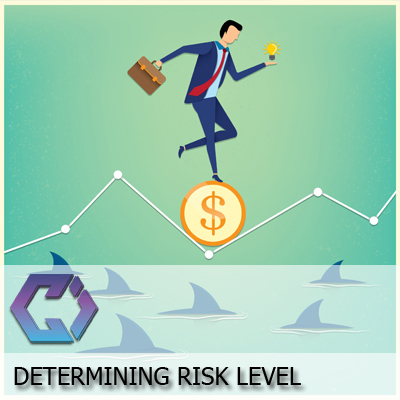
Different Levels of Risk
Meta Description: Different levels of risk exist for different investment choices. Every investment is risky; and that is part of what makes investing interesting. Before you allocate your capital, you must properly understand this.
Introduction
Investopedia defines investing as “the act of allocating resources, usually money, with the expectation of generating an income or profit.” In short, to generate returns. But Investopedia further states that “Risk and return go hand-in-hand in investing.”

From the above, we can deduce that one of the most crucial factors in investing is risk. In search of gains from investing, the investor must be prepared to take on commensurate risk, that is, the possibility of losing the invested amount. Ideally, in investing, the level of risk that the investor undertakes is usually commensurate to the amount of reward that is expected from such investments.
Thus, if the probable reward from the investment is high, then the risk attached is likely to be high. On the other hand, if the potential rewards are low or even fixed, then the risks are usually low as well. Based on the above, we will be dividing investments according to the degree of risk that they carry.
We have high risk, medium risk and low risk.
High Risk
When investments come with a high level of risk, it means that the chances of an investor losing money when he/she undertakes such investment are quite high. We should also note that with the high degree of risks that these investments come with, the amount of reward or return on them is also high.
From derivatives to certain classes of stocks, there is a large number of assets that fall into the high-risk category. However, we can cover just a few.
- Small-cap Stocks
Small caps are listed companies with extremely low market capitalisation. There is no generally-acceptable threshold for small-cap stocks globally, but a common notion in the US and most of West countries is that they have less than $2 billion in market valuation.
Small-cap or penny stocks are considered generally very risky because the companies are very small. So, they, most times, are much less financially stable and thus are more likely to go bankrupt, which will result in the stock falling massively as we saw in the case of Helios and Matheson Analytics (HMNY).
Furthermore, due to their very low value, their stocks are usually very volatile and can experience wild movements within short amounts of time. Similarly, they are easily vulnerable to manipulation by both business executives and private investors.
On the other hand, if they get things right, small-cap stocks do possess high growth potential and can reward investors with hefty returns. There have been instances of ROI of over 1,000% in a single year. Novavax Inc. (NVAX) is a good example.
- Options
Options are financial derivatives that give buyers the right, but not the obligation, to buy or sell an underlying asset at an agreed-upon price and date. There are two main actions in option trades; Calls and Puts. Call options allow the holder to buy the asset at a stated price within a specific time frame.
Put options allow the holder to sell the asset at a stated price within a specific time frame. Options trading carries a very high degree of risk. It is possible for an investor to lose most or all of the capital committed. On the other hand, correct options trades can increase one’s capital by multiple folds.
There are options for almost all types of assets, but the most popular ones are stock options.
- Stocks (Long/Short)
While many investors only invest in stocks, some persons trade them. Trading or day trading as it is popularly called involves buying and selling stocks within a very short amount of time – mostly, during the time frame of one day. Day traders are usually not interested in the fundamentals of a company, but in price movements. As such, they make use of a lot of technical analysis.
One other feature of day trading is the ability for traders to short a stock, that is, to go against the stock. Day trading comes with a great deal of risk, and traders should be ready to contend with the depletion of their capital. Other investments that may fall into the high-risk category include other derivatives such as CFDs (Contract-for-Difference), forex, and cryptocurrencies.
Medium Risk
Investments in this category do not come with the extraordinary amount of risk as those that tagged high-risk. However, they are still risky too. The probability of you losing all your investments in this category is modest. Some of them are discussed below:
- Large-cap Stocks
Stock investing is always risky, but the underlying company you are investing in usually determines the level of risk involved. Large-cap stocks, for example, are stocks of large companies with over $10 billion market cap. They are considered less risky because they are much more financially stable and usually do have established businesses. So, the risks of collapse are greatly reduced.
However, we should note that it is not quite the case that large-cap stocks will deliver extraordinary results over a short amount of time. For instance, Amazon Inc (AMZN) has delivered over 500% in the last 5 years, while some small-cap stocks return over 1,000% in a single year.
- Real Estate
Real estate may also fall under medium-risk investments. Many think that housing prices always go up but that is not the case. In instances of economic downturns like the 2007/08 global financial crises, prices of real estate do fall, and massively too. But the upside is that when the crisis is over, prices do start to pick up.
- Mutual Funds/ETFs
Mutual funds and ETFs pool funds from a large number of people to invest in different securities, especially stocks. In short, mutual funds/ETFs invest on behalf of people and share the proceeds with them.
The risks with mutual funds/ETFs lie with the securities or assets they choose to invest in. Thus, if a mutual fund is heavily focused on small-cap or penny stocks, the risks may be high. Alternatively, if it is focused on say bonds, then the risks attached with the fund are quite low.
Low Risk
Low-risk investments usually do carry fixed returns and they typically include bonds, GICs, and cash.
- Bonds
When you invest in bonds, you are lending money to an entity, and expecting annual coupon (interest) until the bond matures. Bonds here generally refer to a group of fixed-income instruments which also include Treasuries, commercial papers, amongst others. Those who issue bonds include governments – federal, state and municipals – as well as corporations.
There are many factors that make bonds low-risk. The probability that the US or Canadian governments will default on their bonds is very low or even non-existent. The same applies to large corporations, such as Apple Inc (AAPL), that sit on a lot of cash.
Another factor that makes bonds less risky is that in finance, there is the rule that when a company is to be liquidated, bondholders and other creditors are to be paid first, before other claim-holders such as stock investors. Also, every financial year, bondholders must be paid their annual coupons whether the company turns a profit or not.
We must, however, note that the riskiness of a bond is tied to the bond issuer, i.e. the company or government that is borrowing. Small-cap companies or municipal governments may default on their bonds during economic downturns.
- Guaranteed Investment Certificates (GICs)
GICs are a type of investment that offers a guaranteed rate of return over a fixed time. Mostly found in Canada, they are commonly issued by banks, trusts or asset management firms. One important factor that makes GICs particularly less risky is the fact that the Canadian Deposit Insurance Corporation (CIDC) guarantees investments in GICs for up to $100,000.
- Cash
Cash in this case refers to money sitting in your savings account. The risk here is almost non-existent, unless the bank collapses. Even at that, the deposit insurance body is there to secure most of that. You should, however, note that the returns on this are quite negligible.
What Are You to Do as An Investor?
Having been equipped with the knowledge of the risk levels that come with various forms of investments, what to do is evaluate your risk appetite. Are you the type of investor that is comfortable seeing your money deplete quite fast, without any significant anxiety? Then you can be said to have a high risk appetite. Therefore, investments such as options, penny stocks or cryptocurrencies might be a major part of your portfolio.
On the other hand, if you believe ‘slow-but-steady’ works for you, then you likely are an investor with low-risk appetite. Investment products that we may recommend include a combination of treasuries, bonds and large-cap stocks.
Conclusion
Investing involves taking risks, and understanding the amount of risks that come with each investment is one of the most important steps to becoming a better investor. The outline made above should help you understand these risks and how they work for different category of investments.



































































































































































































